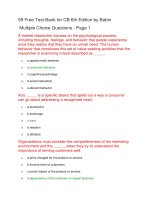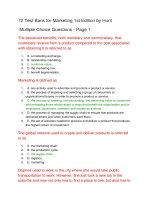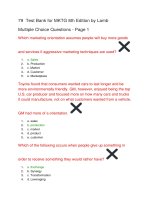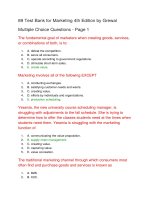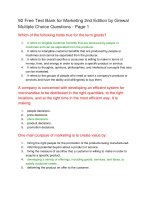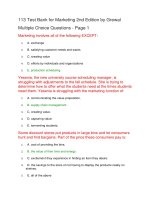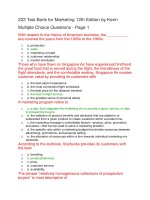Test bank for macroeconomics 12th edition by gordon
Bạn đang xem bản rút gọn của tài liệu. Xem và tải ngay bản đầy đủ của tài liệu tại đây (90.45 KB, 15 trang )
TEST BANK FOR MACROECONOMICS 12TH EDITION BY GORDON
1.1 How Macroeconomics Affects Our Everyday Lives
1) Macroeconomics is the study of
A) the economic issues which affect individual well-being and individual firms' profit levels.
B) the economic issues which affect foreign and domestic prices of related goods and services.
C) inflation and poverty at the level of the household.
D) the economic issues which affect the nation's total income, employment, and output.
Answer: D
Question Status: New
2) Political incumbents often gain or lose re-election because of a strong or weak economy.
Which of the following is an exception to that rule?
A) Al Gore
B) George H.W. Bush
C) Jimmy Carter
D) Herbert Hoover
Answer: A
Question Status: Previous Edition
3) The "Big Three" concepts of Macroeconomics are
A) profits, liquidity, and sustainability.
B) unemployment rate, inflation, and economic growth.
C) asset rebalancing, markups, and profitability.
D) federal budget, foreign trade, and quantitative easing.
Answer: B
Question Status: New
4) Economy with no productivity growth is called the
A) zero-sum society.
B) zero-growth society.
C) export-led society.
D) doomed-to-fail society.
Answer: A
Question Status: New
5) The inflation rate is the
A) measure used to calculate the price level.
B) measure used to calculate the cost of borrowing money.
C) percentage increase in the average level of prices.
D) percentage increase in the average level of wages.
Answer: C
Question Status: Previous Edition
1
Copyright © 2012 Pearson Education, Inc.
6) A rising inflation rate tends to help the following types of people:
A) retirees and students with savings accounts.
B) borrowers and homeowners without mortgages.
C) homeowners with mortgages and students with loans.
D) landowners and borrowers.
Answer: C
Question Status: Previous Edition
7) A rising inflation rate tends to injure the following types of people:
A) retirees and students with savings accounts.
B) borrowers and homeowners.
C) homeowners with mortgages and students with student loans.
D) landowners and borrowers.
Answer: A
Question Status: Previous Edition
8) Inflation tends to redistribute income from
A) savers to borrowers.
B) borrowers to savers.
C) homeowners to landowners.
D) parents to students.
Answer: A
Question Status: Previous Edition
9) A high inflation rate will
A) harm those who have saved while helping those who have borrowed.
B) harm those who have borrowed while helping those who have saved.
C) harm those who have saved and those who have borrowed.
D) benefit those who have saved and those who have borrowed.
Answer: A
Question Status: Previous Edition
10) Which of the three central concepts in macroeconomics is cited in the textbook as being
linked to crime, mental illness, and suicide?
A) the inflation rate
B) the unemployment rate
C) productivity growth
D) None of the above is cited as being linked to these events.
Answer: B
Question Status: Previous Edition
2
Copyright © 2012 Pearson Education, Inc.
11) A high current rate of inflation ________ those who have saved and ________ those who
have borrowed.
A) harms, helps
B) harms, has no effect on
C) helps, helps
D) helps, has no effect on
E) helps, harms
Answer: A
Question Status: Previous Edition
12) The average output produced per worker is one way of measuring
A) inflation.
B) the interest rate.
C) employment.
D) productivity.
Answer: D
Question Status: Previous Edition
13) To avoid the conflicts and suffering of a "zero-sum society," an economy must maintain a
A) positive rate of productivity growth.
B) positive rate of inflation.
C) foreign trade surplus
D) government budget deficit.
Answer: A
Question Status: Previous Edition
14) The branch of macroeconomics concerned with changes in the natural real GDP is the theory
of
A) business cycles.
B) economic growth.
C) GDP gaps.
D) unemployment.
Answer: B
Question Status: Previous Edition
15) The central macroeconomic concept that is most clearly related to changes in the well-being
of the average member of the economy is the
A) unemployment rate.
B) inflation rate.
C) productivity growth rate.
D) None of the above is closely related.
Answer: C
Question Status: Previous Edition
3
Copyright © 2012 Pearson Education, Inc.
1.2 Defining Macroeconomics
1) Among the subjects covered in macroeconomics are the
A) unemployment rate for the entire labor force, and the causes of the increase in the overall
price level.
B) causes of the increase in the price of oil relative to other commodities.
C) effects of low wages on the laborers' moral.
D) causes of the change in the individual firms' profits.
Answer: A
Question Status: Previous Edition
2) Which of the following does Gordon believe people consider the single most important
macroeconomic issue today?
A) inflation
B) poverty
C) unemployment
D) low productivity
Answer: C
Question Status: Previous Edition
3) The unemployment rate is the number of
A) people looking for work divided by the population.
B) jobless individuals divided by the total labor force.
C) jobless people looking for work divided by the population.
D) jobless individuals looking for work divided by those employed and unemployed but actively
looking.
Answer: D
Question Status: Previous Edition
4) Generally, the higher the level of output in an economy is the ________ will be.
A) lower the unemployment rate and inflation rate
B) higher the unemployment rate and inflation rate
C) higher the unemployment rate and the lower inflation rate
D) lower the unemployment rate and the higher inflation rate
Answer: D
Question Status: Previous Edition
5) A low unemployment rate implies that
A) job offers are scarce and inflation is high.
B) job offers are plentiful and wages are high.
C) jobs are permanent and job offers are plentiful.
D) jobs are difficult to find, and wages are low.
Answer: B
Question Status: Previous Edition
4
Copyright © 2012 Pearson Education, Inc.
6) Microeconomics focuses on
A) the relationships among the different parts of the economy.
B) the totals, or aggregates, of the economy.
C) unemployment.
D) business cycles.
Answer: A
Question Status: New
7) Macroeconomics is the study of
A) the role of the individual in an economy.
B) The overall performance of an economy.
C) how a private economy would function in the absence of government involvement.
D) how one economy trades with other economies.
E) the role of government in an economy.
Answer: B
Question Status: Previous Edition
8) Do macroeconomic issues concern the well-being of the typical individual member of an
economy?
A) No, since we are focusing on the behavior of aggregate quantities.
B) No, since most individuals have little contact with other economies in the world.
C) Yes, since macroeconomic events have widespread effects on everyday lives.
D) Yes, since macroeconomics focuses on the decisions constantly being made by the average
individual.
Answer: C
Question Status: Previous Edition
9) Macroeconomics focuses on a certain set of variables called
A) micros.
B) marginals.
C) partials.
D) balances.
E) aggregates.
Answer: E
Question Status: Previous Edition
10) As an example of the simplifications that make economic theorizing possible, the major
economic "totals" are assumed to be constant in the study of
A) government budget deficits.
B) macroeconomics.
C) economic aggregates.
D) microeconomics.
E) unemployment and inflation.
Answer: D
Question Status: Previous Edition
5
Copyright © 2012 Pearson Education, Inc.
1.3 Actual and Natural Real GDP
Figure 1-1
1) When the actual unemployment rate is likely to exceed the natural rate of unemployment, as in
the time intervals between t1 and t2 and t3 and t4 in Figure 1-1 above, we can expect that
A) inflation is speeding up and real GDP is likely to exceed natural GDP.
B) inflation is slowing down and real GDP is likely to fall below natural GDP.
C) inflation is speeding up and natural GDP is likely to exceed real GDP.
D) inflation is slowing down and real GDP is likely to exceed natural GDP.
Answer: B
Question Status: Previous Edition
Figure 1-2
2) When the actual real GDP exceeds the natural real GDP as in Figure 1-2 above, we expect to
find that unemployment is
A) high and inflation is high.
B) low and inflation is high.
C) low and inflation is low.
D) high and inflation is low.
Answer: B
Question Status: Previous Edition
6
Copyright © 2012 Pearson Education, Inc.
3) The natural level of real GDP is that level of
A) real GDP at which the price level will continue increasing.
B) nominal GDP at which the price level will remain constant.
C) real GDP at which there is no tendency for inflation to accelerate or decelerate.
D) Nominal real GDP at which the price level will continue to decrease.
Answer: C
Question Status: New
4) Which of the following is a criterion by which Gordon judges the desirability of any given
level of actual real GDP?
A) Actual real GDP is too low if it causes the unemployment rate to be higher than necessary.
B) Actual real GDP is too high if it strains a nation's ability to produce and puts upward pressure
on the inflation rate.
C) Actual real GDP is at a desirable level if there is no tendency for inflation to accelerate or
decelerate.
D) All of the above.
Answer: D
Question Status: Previous Edition
5) The output gap is zero when
A) Actual real GDP > Natural real GDP.
B) Actual real GDP = Natural real GDP.
C) Actual real GDP < Natural real GDP.
D) Natural real GDP = 0.
Answer: B
Question Status: Previous Edition
6) The "zero sum" society is
A) a society that has reached its limit in population growth and has placed quotas on its birth
rate.
B) a society where the rate of growth of GDP minus the inflation rate equals zero.
C) a society in which the fluctuations of GDP around the natural level of output sum to zero.
D) a society with no productivity growth in which any additional good enjoyed by one person
requires that something be taken away from someone else.
Answer: D
Question Status: Previous Edition
7) Business cycles in the United States
A) tend to occur at regular intervals and are periodic.
B) tend to recur at irregular intervals, but are usually of the same length.
C) were quite common before World War II but have not occurred in the postwar period.
D) tend to have expansions that last longer than the recessions.
Answer: D
Question Status: Previous Edition
7
Copyright © 2012 Pearson Education, Inc.
8) "Natural" real GDP is defined as the total output
A) at business cycle peaks.
B) at business cycle troughs.
C) that causes an inflation rate of zero.
D) that causes the inflation rate to remain constant.
E) produced when all of our resources are being used to their maximum capacity.
Answer: D
Question Status: Previous Edition
9) When actual real GDP is equal to the natural real GDP, the unemployment rate is
A) zero.
B) at its "natural" rate.
C) accelerating.
D) decelerating.
Answer: B
Question Status: Previous Edition
10) Suppose that the natural rate of unemployment is 5.7 percent. If unemployment has for some
time been varying between 5.1 and 5.3 percent, we should be at an actual real GDP ________ the
natural real GDP, and should expect inflation to be ________.
A) below, slowing down
B) below, speeding up
C) above, slowing down
D) above, constant
E) above, speeding up
Answer: E
Question Status: Previous Edition
11) We are told that over the past year actual real GDP has risen by three percent. This fact alone
is enough to tell us that
A) the unemployment rate has fallen.
B) the inflation rate has risen.
C) the actual real GDP is above natural real GDP.
D) productivity has grown.
E) none of the above.
Answer: E
Question Status: Previous Edition
1.4 Macroeconomics in the Short Run and Long Run
1) The period of the business cycle between the peak and the trough is the
A) recession.
B) expansion.
C) recovery.
D) All of the above may fall between the peak and the trough.
Answer: A
Question Status: Previous Edition
8
Copyright © 2012 Pearson Education, Inc.
2) The period of the business cycle which follows the trough is the
A) recession.
B) expansion.
C) peak.
D) All of the above may follow the trough.
Answer: B
Question Status: Previous Edition
3) Immediately following a business cycle "peak" comes a
A) "trough."
B) "recession."
C) "expansion."
D) "recurrence."
Answer: B
Question Status: Previous Edition
4) At a business cycle peak, we usually have ________ real Gross Domestic Product.
A) an all-time high level of
B) an all-time low level of
C) an historically average level of
D) accelerating growth of
E) the maximum growth rate of
Answer: A
Question Status: Previous Edition
5) Approaching a business cycle trough we find actual real GDP ________ natural real GDP, so
inflation is ________.
A) below, slowing down
B) below, speeding up
C) above, slowing down
D) above, speeding up
Answer: A
Question Status: Previous Edition
6) Approaching a business cycle peak, actual real GDP ________ natural real GDP, which causes
inflation to ________.
A) exceeds, remain constant
B) exceeds, accelerate
C) is less than, decelerate
D) equals, accelerate
E) equals, remain constant
Answer: B
Question Status: Previous Edition
9
Copyright © 2012 Pearson Education, Inc.
7) Given the path of natural real GDP growth, economists prefer an economy such as ________,
in which the real GDP gaps are ________.
A) Stabilia's, minimized
B) Stabilia's, maximized
C) Volatilia's, minimized
D) Volatilia's, maximized
Answer: A
Question Status: Previous Edition
8) In an economy where actual real GDP is always equal to the natural real GDP, inflation
A) settles down to zero percent.
B) is at the same rate as GDP growth.
C) is constant at a rate that can be low or high.
D) fluctuates around an average of zero percent.
Answer: C
Question Status: Previous Edition
1.5 Case Study: How Does the Global Economic Crisis Compare to Previous Business Cycles?
1) Between 1900 and 2007, the ratio of actual to natural real GDP hit its low point in
A) 1933.
B) 1904.
C) 1944.
D) 1982.
Answer: A
Question Status: Previous Edition
2) In 1991 the unemployment rate in the United States rose to 7.1 percent. This is ________ the
unemployment rate reached in the depths of the Great Depression.
A) about two percentage points more than
B) roughly equal to
C) about three percentage points less than
D) about half of
E) less than one-third of
Answer: E
Question Status: Previous Edition
3) In the United States, the most recent period in which the unemployment rate stayed below the
natural unemployment rate for several consecutive years was
A) the early 1930s.
B) the late 1940s.
C) the late 1960s.
D) the mid 1980s.
E) the late 1990s.
Answer: E
Question Status: Previous Edition
10
Copyright © 2012 Pearson Education, Inc.
4) International influences have become relatively ________ important for the U.S. economy in
recent decades, as we become a more ________ economy.
A) less, "open"
B) less, "closed"
C) more, "open"
D) more, "closed"
Answer: C
Question Status: Previous Edition
5) By participating in international financial markets, a nation can finance its government budget
deficit in part by ________, which ________ the link between the nation's deficit and its internal
private investment.
A) buying foreign assets, strengthens
B) buying foreign assets, weakens
C) selling assets to foreigners, strengthens
D) selling assets to foreigners, weakens
Answer: D
Question Status: Previous Edition
6) Going from a closed to an open economy ________ macroeconomic policymaking, especially
now that exchange rates are ________.
A) complicates, flexible
B) complicates, fixed
C) simplifies, flexible
D) simplifies, fixed
Answer: A
Question Status: Previous Edition
7) Prior to 1995 productivity growth in Europe was ________ in the United States.
A) higher than
B) lower than
C) same as
D) None of the above
Answer: A
Question Status: New
8) Compared to the US, the unemployment rate in Europe was ________ throughout the 1960s
and 1970s and ________ after 1980.
A) higher; lower
B) lower; higher
C) lower; remained lower
D) higher, remained higher
Answer: B
Question Status: Previous Edition
11
Copyright © 2012 Pearson Education, Inc.
9) After 1995 U.S. growth rate ________ and the European Rate ________
A) slowed down; speeded up
B) speeded up; slowed down
C) slowed down; slowed down
D) speeded up, speeded up
Answer: B
Question Status: New
1.6 Macroeconomics at the Extremes
1) Hyperinflation can be defined as an inflation rate of
A) 50% or more per month.
B) 50% or more per year.
C) 50% or more decade.
D) All of the above are appropriately defined as hyperinflation.
Answer: A
Question Status: Previous Edition
2) The U.S. business cycle record, in common with most, has
A) peaks lasting longer than troughs.
B) troughs lasting longer than peaks.
C) recessions lasting longer than expansions.
D) expansions lasting longer than recessions.
Answer: D
Question Status: Previous Edition
3) Over the period between 1960 and 2010, the increase in unemployment rate was the greatest
in
A) early 1960s.
B) late 2000s.
C) mid 1970s.
D) early 1980s.
E) early 1990s.
Answer: B
Question Status: New
4) The recession of 1990-1992 ________ the trend set over 1965-1990 of ________
unemployment rates at each successive cyclical trough.
A) continued, lower
B) continued, higher
C) broke, lower
D) broke, higher
Answer: D
Question Status: Previous Edition
12
Copyright © 2012 Pearson Education, Inc.
5) Which of the following contributed to the emergence of hyperinflation in Germany in the
early 1920s?
A) payment of massive war reparations required by the Versailles Peace Treaty
B) huge budget deficits financed by printing paper money
C) decreased desire to hold money on the part of the German people
D) All of the above
Answer: D
Question Status: Previous Edition
6) Gordon states that ________ caused the substantial increase in the standard of living in South
Korea relative to that of the Philippines during the period 1960-2010.
A) lower unemployment rates
B) higher inflation rates
C) higher rate of growth in per capita real GDP.
D) All of the above
Answer: C
Question Status: New
7) In 1999 the European unemployment rate was ________ that in the United States.
A) double
B) triple
C) equal to
D) lower compared to
Answer: A
Question Status: New
1.7 Taming Business Cycles: Stabilization Policy
1) Are government activities of any concern to macroeconomists?
A) Yes, since government actions and policies can affect an economy's overall performance.
B) Yes, since macroeconomics is defined as the study of the role that government plays in the
economy.
C) No, since the government cannot affect the functioning of the private economy.
D) No, since macroeconomists study hypothetical economies that have no government
involvement at all.
Answer: A
Question Status: Previous Edition
2) In policy discussions macroeconomic aggregates (inflation, unemployment, and productivity)
are called
A) monetary variables.
B) fiscal variables.
C) target variables.
D) interest variables.
Answer: C
Question Status: New
13
Copyright © 2012 Pearson Education, Inc.
3) Much of macroeconomics is concerned with advising governments on ways to ________
business cycles, since it is desirable to ________.
A) amplify, create the greatest cyclical peaks possible
B) amplify, create deep recessions to cool down the economy
C) dampen, avoid both very low troughs and very high peaks
D) dampen, keep the economy at its maximum productive capacity
Answer: C
Question Status: Previous Edition
4) Our business cycle experiences suggest that a macroeconomic policy designed to lower the
average rate of inflation will require ________ in actual real GDP and an accompanying
________ in the unemployment rate.
A) an increase, increase
B) an increase, decrease
C) a reduction, increase
D) a reduction, decrease
Answer: C
Question Status: Previous Edition
5) Why would macroeconomists rate economic performance in Speed-Nation superior to that in
Stag-Nation? Speed-Nation has
A) milder business cycles.
B) more volatile business cycles.
C) faster economic growth.
D) larger real GDP gaps.
E) smaller real GDP gaps.
Answer: C
Question Status: Previous Edition
6) The proper short-run goal of macroeconomic policymakers is to
A) amplify the business cycle.
B) dampen the business cycle.
C) promote high economic growth.
D) maintain low economic growth.
Answer: B
Question Status: Previous Edition
7) Any policy that seeks to influence the level of aggregate demand is called
A) productivity policy.
B) stabilization policy.
C) aggregate policy.
D) employment policy.
Answer: B
Question Status: New
14
Copyright © 2012 Pearson Education, Inc.
8) Policy that tries to influence target variables by changing the interest rate is called
A) fiscal policy.
B) interest rate policy.
C) recession policy.
D) monetary policy.
Answer: D
Question Status: New
9) Fiscal policy tries to influence target variables by manipulating
A) money supply.
B) interest rates.
C) government expenditures.
D) All of the above.
Answer: C
Question Status: Previous Edition
10) Policy that tries to influence target variables by changing the tax rates is called
A) fiscal policy.
B) tax rate policy.
C) recession policy.
D) monetary policy.
Answer: A
Question Status: New
11) According to Gordon, for which of the following should policymakers set a target rate of
zero?
A) productivity growth
B) inflation rate
C) unemployment rate
D) None of the above
Answer: D
Question Status: Previous Edition
1.8 The "Internationalization" of Macroeconomics
1) There are no questions for this section.
Answer:
15
Copyright © 2012 Pearson Education, Inc.
